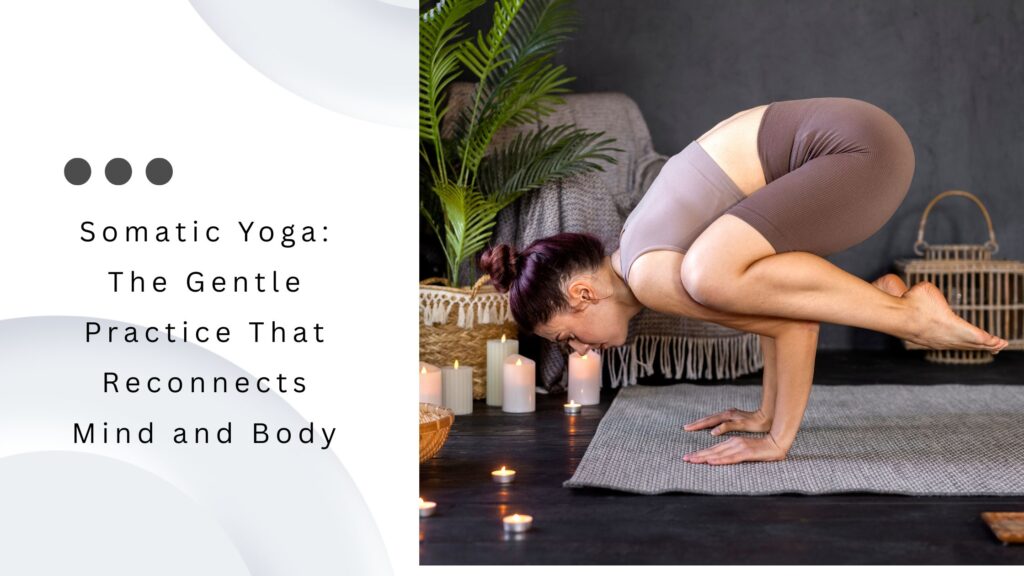In our fast-paced, overstimulated world, many of us live in our heads—disconnected from the subtle signals our bodies send us. Chronic stress, poor posture, and unresolved trauma accumulate over time, manifesting as tension, pain, and burnout. But what if there was a gentle yet powerful practice that could help you release this deeply held tension, restore balance, and heal from the inside out?
Welcome to somatic yoga—a revolutionary approach to movement that blends traditional yoga with somatic therapy to help you deeply reconnect with your body. Unlike conventional yoga styles focused on achieving perfect poses, somatic yoga is about sensing, feeling, and moving from within. It’s about creating space for healing, presence, and embodied awareness.
In this guide, we’ll dive deep into what somatic yoga is, how it works, its numerous benefits, and how you can begin your own journey toward inner harmony.
Somatic yoga is a soothing and therapeutic approach that blends traditional yoga with somatic movement therapy to deepen the mind-body connection. It focuses on slow, mindful movements and heightened body awareness, helping to relieve stress while fostering a stronger connection to both physical sensations and emotional well-being.
Table of Contents
What Is Somatic Yoga?
Somatic yoga combines the principles of somatics—a body-centered approach to movement and awareness—with traditional yoga practices. The term “somatic” comes from the Greek word soma, meaning “the living body in its wholeness.” In somatic yoga, the focus is on internal sensation, not external performance.
While traditional yoga often emphasizes alignment, flexibility, or strength, somatic yoga invites you to slow down and tune into the subtle messages of your nervous system. It’s less about doing and more about feeling. Each movement is performed with mindfulness, intention, and awareness.
Key Characteristics of Somatic Yoga:
- Movements are slow, mindful, and often performed on the floor.
- Emphasis on the felt sense (interoception) rather than visual alignment.
- Practices are designed to re-educate the nervous system and release chronic muscle tension.
- Encourages a deeper connection between body, mind, and breath.
This practice is especially beneficial for people experiencing chronic stress, anxiety, trauma, or physical pain.
The Science Behind Somatic Movement
At the heart of somatic yoga is the idea that our bodies hold onto emotional and physical stress. Over time, these stress patterns become unconscious—manifesting as tight shoulders, shallow breathing, or an achy lower back. Somatic movement helps rewire these patterns through a process called neuromuscular reeducation.
One core technique used in somatic yoga is pandiculation—a natural movement that resets muscle length and tension by contracting, releasing, and relaxing muscles consciously. This technique is more effective than static stretching because it teaches the brain to let go of chronic holding patterns.
The practice works directly with the nervous system, especially the autonomic nervous system, to regulate stress responses and promote healing. As a result, somatic yoga can offer profound relief for both physical and emotional tension.
Benefits of Somatic Yoga
The benefits of somatic yoga are both immediate and long-lasting. Whether you’re seeking relief from chronic pain or looking to cultivate deeper body awareness, somatic yoga offers a gentle path toward whole-body wellness.
Physical Benefits:
- Releases habitual muscle tension and stiffness.
- Improves posture and functional movement.
- Enhances body awareness and coordination.
- Supports injury prevention and rehabilitation.
- Promotes healthy joint mobility and flexibility.
Mental and Emotional Benefits:
- Reduces anxiety and chronic stress.
- Enhances mind-body connection and self-awareness.
- Encourages emotional release and trauma processing.
- Improves sleep and relaxation.
- Increases resilience and emotional regulation.
These outcomes make somatic yoga especially effective for individuals with conditions like fibromyalgia, PTSD, chronic fatigue, and anxiety disorders.
Read More: Ashtanga Yoga: The Ultimate Path to Strength, Discipline, and Inner Peace
Read More: Yoga Nidra: The Ultimate Guide to Deep Rest and Inner Awakening
Who Should Practice Somatic Yoga?
One of the most beautiful aspects of somatic yoga is its accessibility. It’s a practice for every body—regardless of age, fitness level, or experience.
Ideal for:
- Beginners who want a gentle, low-impact entry into yoga.
- Individuals healing from injuries, trauma, or chronic pain.
- Athletes and active individuals seeking recovery and balance.
- Anyone feeling disconnected from their body or overwhelmed by stress.
- Seniors looking to improve mobility without strain.
Because movements are simple and adaptable, even those with limited mobility or chronic conditions can benefit from somatic yoga.
What Happens in a Somatic Yoga Class?
If you’re used to fast-paced vinyasa or rigorous power yoga classes, somatic yoga might feel radically different—and that’s the point.
What to Expect:
- A calm, quiet environment—often with soft lighting and soothing music.
- Most practices begin on the floor with simple, exploratory movements.
- Instructors guide you to move slowly and mindfully while paying attention to internal sensations.
- No pressure to “perform” or achieve a specific pose.
- Emphasis on breath, grounding, and nervous system regulation.
Every session is designed to create a safe container for exploration, self-discovery, and deep healing.
Common Somatic Yoga Techniques and Practices
Somatic yoga doesn’t follow a rigid structure. Instead, it offers a toolbox of gentle practices tailored to your needs in the moment.
Key Practices Include:
- Pandiculation: Conscious contraction and release of muscles to reset tension.
- Somatic Breathing: Using breath to deepen interoception and release holding patterns.
- Body Scans: Guided awareness to reconnect with different areas of the body.
- Micro-movements: Subtle motions to re-pattern the nervous system.
- Fascia release: Slow movement to unwind tension stored in connective tissues.
These techniques are especially helpful for addressing chronic pain, anxiety, and even trauma stored in the body.
Somatic Yoga vs Traditional Yoga Styles
You might be wondering: how is somatic yoga different from Hatha, Yin, or restorative yoga? While all yoga styles offer benefits, somatic yoga stands out for its unique approach to inner sensing.
Rather than striving to “achieve” a pose, somatic yoga encourages you to “experience” it from the inside out.
| Feature | Somatic Yoga | Hatha Yoga | Yin Yoga |
| Focus | Internal sensation | Alignment & posture | Deep stretching |
| Pace | Very slow | Moderate | Slow |
| Goal | Neuromuscular reeducation | Physical fitness & flexibility | Fascia release |
| Experience | Beginner-friendly | All levels | All levels |
How to Start a Somatic Yoga Practice
Ready to explore the world of somatic yoga? The good news is that you don’t need fancy equipment or years of experience to begin.
Tips to Get Started:
- Start with Online Classes: Many somatic yoga teachers offer virtual sessions. Look for classes focused on “somatic movement,” “gentle yoga,” or “nervous system regulation.”
- Explore YouTube Channels: Search for somatic yoga routines or beginner sessions to get a feel for the practice.
- Create a Calm Space: Use a yoga mat, a blanket, and maybe a bolster or pillow to support your practice.
- Listen to Your Body: The key to somatic yoga is internal listening. Let go of judgment and follow your own rhythm.
- Stay Consistent: Even 10–15 minutes a day can have a powerful impact over time.
You might also explore somatic yoga books like “The Body Keeps the Score” by Bessel van der Kolk or online programs from teachers like Thomas Hanna, Eleanor Criswell, or Martha Peterson.

Final Thoughts: Why Somatic Yoga Might Be Exactly What You Need
Somatic yoga is more than just a movement practice—it’s a journey back home to your body. In a culture that glorifies speed, productivity, and perfection, this gentle yet powerful approach reminds us to slow down, feel, and be.
Whether you’re healing from trauma, recovering from injury, or simply yearning for a deeper connection with yourself, somatic yoga offers a nurturing path forward. It’s an invitation to listen, to release, and to return to your natural state of balance and ease.
So roll out your mat, close your eyes, and take a breath. Your body has been waiting for you.
FAQ:
Q. What is somatic yoga and how is it different from regular yoga?
Ans: Somatic yoga is a gentle, mindful practice that focuses on internal body awareness, nervous system regulation, and releasing chronic tension. Unlike traditional yoga styles that emphasize holding poses or achieving flexibility, somatic yoga invites slow, intentional movements that retrain your brain and body to let go of stress and pain. It’s ideal for healing, trauma recovery, and restoring the mind-body connection.
Q. Can somatic yoga help with chronic pain and stress?
Ans: Yes, somatic yoga is highly effective for chronic pain relief and stress reduction. Through techniques like pandiculation and somatic breathing, it helps release long-held muscular tension and calms the nervous system. It’s commonly recommended for conditions such as fibromyalgia, back pain, tension headaches, and anxiety
Q. Is somatic yoga suitable for beginners or people with limited mobility?
Ans: Absolutely. Somatic yoga is beginner-friendly and designed to be accessible for all body types and ages. Most movements are done slowly on the floor, making it ideal for seniors, people recovering from injuries, or anyone who finds faster-paced yoga styles overwhelming. You don’t need flexibility or experience—just a willingness to tune into your body.
Q. How often should I practice somatic yoga to see results?
Ans: Even practicing somatic yoga for 10–20 minutes a few times a week can lead to noticeable improvements in posture, pain levels, and mental clarity. Consistency is key, as this practice works by gradually re-educating your nervous system. Many practitioners notice greater ease and body awareness within just a few sessions.
Q. Where can I find somatic yoga classes or online resources?
Ans: You can find somatic yoga classes through local wellness centers, yoga studios, or online platforms like YouTube and dedicated somatic education websites. Search for terms like “somatic yoga online classes,” “gentle yoga for trauma,” or “nervous system regulation yoga.” There are also excellent books and programs by teachers like Thomas Hanna, Eleanor Criswell, and Martha Peterson.
Q.What is a somatic yoga practice?
Ans: Somatic yoga blends traditional yoga with somatics—a movement-based therapy focused on retraining the brain and body to better sense and control muscles. While research on somatic yoga is still emerging, early findings indicate it may help alleviate stress, ease pain, and support trauma recovery.
Q. What are the best somatic exercises?
Ans: Yoga, tai chi, meditation, and qigong are all time-honored somatic practices centered on cultivating awareness of bodily sensations and movement. Additional examples include dance, Pilates, and aikido.
Q. What is the difference between gentle yoga and somatic yoga?
Ans: The primary distinction between traditional Hatha Yoga and Gentle Somatic Yoga (GSY) lies in the intention behind the practice. While Hatha Yoga often focuses on stretching muscles, GSY emphasizes retraining and strengthening the connection between the brain and muscles instead.
Q. How often should I do somatic yoga?
Ans: Like any new habit, the key to gaining the full benefits of somatic exercises is consistency. Try to include somatic practices in your daily routine, even if it’s just for a few minutes each day.
Declaration Note:
We use third-party videos and images on https://yogavidhi.com/ for educational and illustrative purposes. All rights belong to their respective owners. No copyright infringement is intended.



